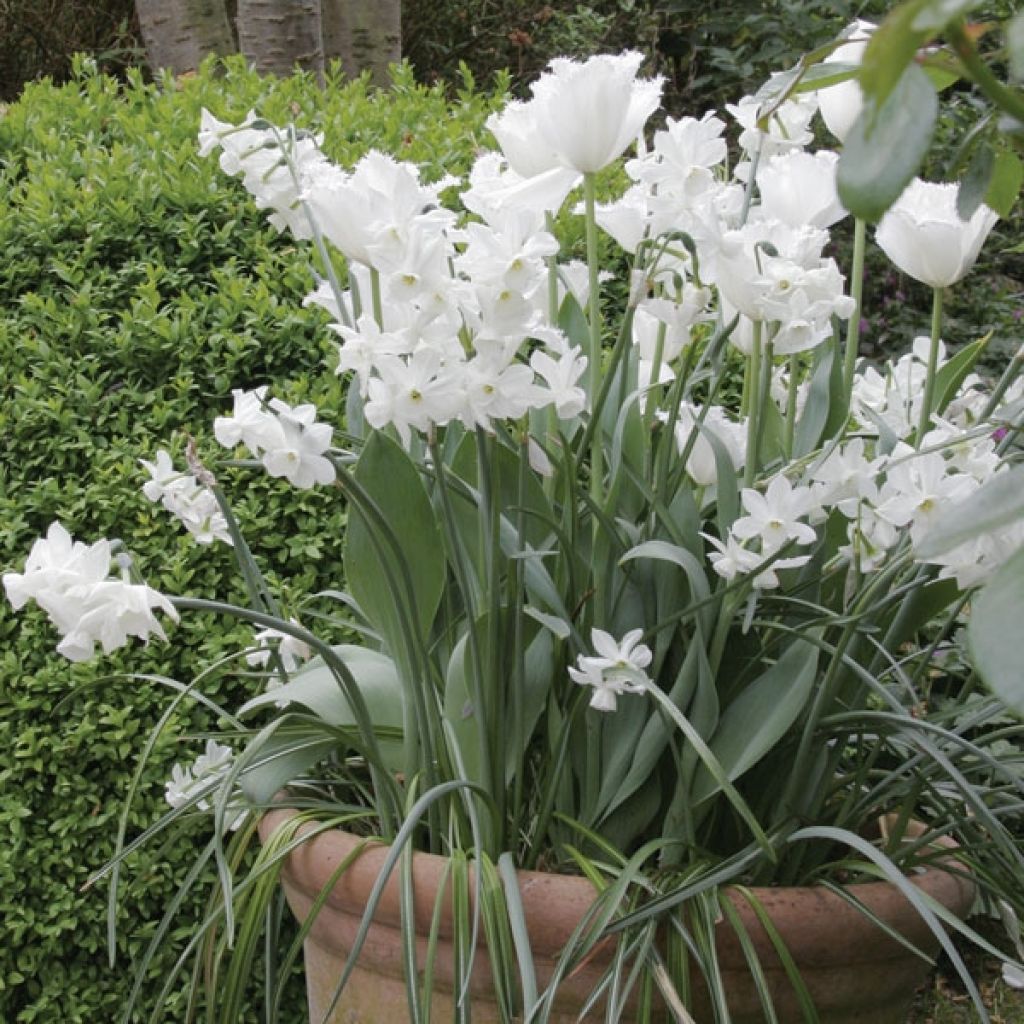

White Pot
White Pot
Tulipa, Narcissus,Crocus
Disappointed as I didn't have any tulips. The rest of the flowerpot is splendid.
Helene, 21/04/2019
This plant carries a 6 months recovery warranty
More information
We guarantee the quality of our plants for a full growing cycle, and will replace at our expense any plant that fails to recover under normal climatic and planting conditions.
From €5.90 for pickup delivery and €6.90 for home delivery
Express home delivery from €8.90.

Does this plant fit my garden?
Set up your Plantfit profile →
Collection items (55 plants)
Description
This White Pot brings together carefully selected bulbs of crocuses, narcissus, and tulips for their white blooms, which will follow one another from February-March to April-May. The same composition can be done in the garden, in a flower bed, along a border, or in a perennial bed. Once planted, these easy-to-grow bulbs will bloom year after year and naturalise over time.
This White Pot consists of:
20 Triumph White Dream tulips: an elegant and bright variety with a narrow corolla of pure white, carried by 40 cm (16 in) stems. This variety blooms in the middle of spring from April onwards.
10 Triandrus Narcissus Thalia: an old variety with small, lightly scented white flowers of timeless simplicity. Each stem bears 2 to 3 delicate flowers, at a height of 35 cm (14 in) from the ground. It blooms in April-May.
25 Mammoth Jeanne d'Arc crocuses: an old variety with large, particularly bright flowers that are easy to grow. This crocus charms with its large, diaphanous pure white flowers, open on a small cluster of orange stamens. They bloom in February-March.
A total of 55 bulbs packaged separately and labelled.
This collection is perfect for filling a large planter, a small flower bed, or a rockery.
In a flower bed or rockery: scatter the bulbs in the ground, burying them at the recommended depth for each plant:
- for crocuses: 5 cm (2 in) deep and 5 cm (2 in) apart or in groups of three every 15 or 20 cm (6 or 8 in).
- for narcissus: 10 cm (4 in) deep and spaced 10 cm (4 in) apart.
- for tulips: 15 cm (6 in) deep, spacing them 10 cm (4 in) apart.
In a container: plant your bulbs very close together, without touching the edge of the pot, and spaced 1 cm (0.4 in) apart. You can plant pots of the same variety, but you can also plant them in layered tiers to have blooms for more than 2 months. Use pots with drainage holes at the bottom and filled with a layer of large stones (at least 5 cm (2 in)) to ensure drainage, and a good potting soil, possibly mixed with garden soil if available (in a 50:50 ratio), and kept moist. Protect your pots in winter and bring them out as soon as the bulb shoots appear.
The leaves of narcissus, tulips, and crocuses naturally wither a few weeks after flowering: do not prune them until they have completely turned yellow, as they allow the bulb to replenish its reserves for the following spring's flowering.
Report an error about the product description
Plant habit
Flowering
Foliage
Botanical data
Tulipa, Narcissus,Crocus
Cultivar or hybrid
Planting and care
Plant your bulbs very close together, without touching the edge of the pot and spaced 1 cm (0.4 in) apart. You can plant pots of the same variety, but also plant in layered tiers to obtain flowering for more than 2 months. Use pots with holes in the bottom and filled with a layer of large stones (minimum 5 cm (2 in)) to ensure drainage, and a good compost, possibly mixed with garden soil, if you have it (in a 50:50 ratio) to keep it moist. Protect your pots in winter and take them out as soon as the shoots of the bulbs appear.
Planting period
Intended location
Care
-
, onOrder confirmed
Reply from on Promesse de fleurs
Haven't found what you were looking for?
Hardiness is the lowest winter temperature a plant can endure without suffering serious damage or even dying. However, hardiness is affected by location (a sheltered area, such as a patio), protection (winter cover) and soil type (hardiness is improved by well-drained soil).

Photo Sharing Terms & Conditions
In order to encourage gardeners to interact and share their experiences, Promesse de fleurs offers various media enabling content to be uploaded onto its Site - in particular via the ‘Photo sharing’ module.
The User agrees to refrain from:
- Posting any content that is illegal, prejudicial, insulting, racist, inciteful to hatred, revisionist, contrary to public decency, that infringes on privacy or on the privacy rights of third parties, in particular the publicity rights of persons and goods, intellectual property rights, or the right to privacy.
- Submitting content on behalf of a third party;
- Impersonate the identity of a third party and/or publish any personal information about a third party;
In general, the User undertakes to refrain from any unethical behaviour.
All Content (in particular text, comments, files, images, photos, videos, creative works, etc.), which may be subject to property or intellectual property rights, image or other private rights, shall remain the property of the User, subject to the limited rights granted by the terms of the licence granted by Promesse de fleurs as stated below. Users are at liberty to publish or not to publish such Content on the Site, notably via the ‘Photo Sharing’ facility, and accept that this Content shall be made public and freely accessible, notably on the Internet.
Users further acknowledge, undertake to have ,and guarantee that they hold all necessary rights and permissions to publish such material on the Site, in particular with regard to the legislation in force pertaining to any privacy, property, intellectual property, image, or contractual rights, or rights of any other nature. By publishing such Content on the Site, Users acknowledge accepting full liability as publishers of the Content within the meaning of the law, and grant Promesse de fleurs, free of charge, an inclusive, worldwide licence for the said Content for the entire duration of its publication, including all reproduction, representation, up/downloading, displaying, performing, transmission, and storage rights.
Users also grant permission for their name to be linked to the Content and accept that this link may not always be made available.
By engaging in posting material, Users consent to their Content becoming automatically accessible on the Internet, in particular on other sites and/or blogs and/or web pages of the Promesse de fleurs site, including in particular social pages and the Promesse de fleurs catalogue.
Users may secure the removal of entrusted content free of charge by issuing a simple request via our contact form.
The flowering period indicated on our website applies to countries and regions located in USDA zone 8 (France, the United Kingdom, Ireland, the Netherlands, etc.)
It will vary according to where you live:
- In zones 9 to 10 (Italy, Spain, Greece, etc.), flowering will occur about 2 to 4 weeks earlier.
- In zones 6 to 7 (Germany, Poland, Slovenia, and lower mountainous regions), flowering will be delayed by 2 to 3 weeks.
- In zone 5 (Central Europe, Scandinavia), blooming will be delayed by 3 to 5 weeks.
In temperate climates, pruning of spring-flowering shrubs (forsythia, spireas, etc.) should be done just after flowering.
Pruning of summer-flowering shrubs (Indian Lilac, Perovskia, etc.) can be done in winter or spring.
In cold regions as well as with frost-sensitive plants, avoid pruning too early when severe frosts may still occur.
The planting period indicated on our website applies to countries and regions located in USDA zone 8 (France, United Kingdom, Ireland, Netherlands).
It will vary according to where you live:
- In Mediterranean zones (Marseille, Madrid, Milan, etc.), autumn and winter are the best planting periods.
- In continental zones (Strasbourg, Munich, Vienna, etc.), delay planting by 2 to 3 weeks in spring and bring it forward by 2 to 4 weeks in autumn.
- In mountainous regions (the Alps, Pyrenees, Carpathians, etc.), it is best to plant in late spring (May-June) or late summer (August-September).
The harvesting period indicated on our website applies to countries and regions in USDA zone 8 (France, England, Ireland, the Netherlands).
In colder areas (Scandinavia, Poland, Austria...) fruit and vegetable harvests are likely to be delayed by 3-4 weeks.
In warmer areas (Italy, Spain, Greece, etc.), harvesting will probably take place earlier, depending on weather conditions.
The sowing periods indicated on our website apply to countries and regions within USDA Zone 8 (France, UK, Ireland, Netherlands).
In colder areas (Scandinavia, Poland, Austria...), delay any outdoor sowing by 3-4 weeks, or sow under glass.
In warmer climes (Italy, Spain, Greece, etc.), bring outdoor sowing forward by a few weeks.





































